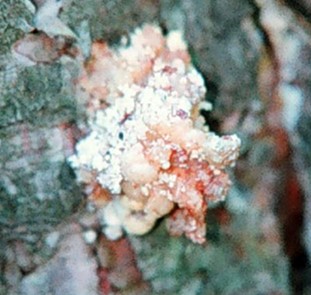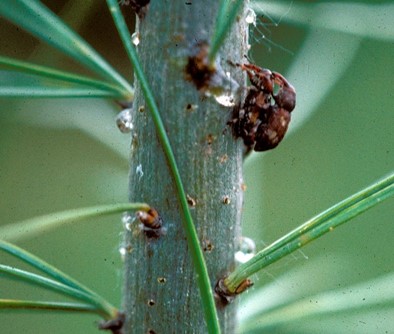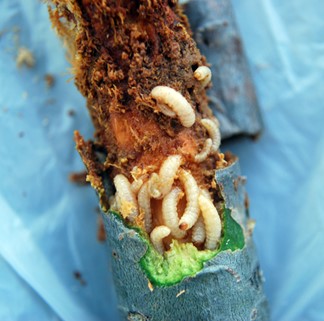Getting ready for those early insects in Christmas tree and nursery fields
It’s never too early to begin scouting your trees and fields for early season pests, such as Zimmerman pine moth and white pine weevil.
It has been a long, cold, snowy winter. As March roars in, it will soon be time to think about aphids, adelgids, borers, weevils and other pests. Now that the snow has melted, walk through your fields and examine your trees carefully. What sort of insect damage are left from last year? Are there galls on the spruce trees? Did white pine weevil kill the terminal leaders of some of the pine or spruce trees? How do the needles of the Douglas fir trees look? Are they curled or bent from Cooley adelgid? Or are they browning due to Swiss needlecast? Maybe there’s little white pine needle scales or black sooty mold on the Scots pine needles. Don’t forget to look at the stems of trees. Big pitch globs on the stem usually mean Zimmerman pine moth is present.

Zimmerman pine moth in Scots and Austrian pines
Zimmerman pine moth is an insect that can be a real problem if you have Scots and Austrian pine. This insect overwinters as a tiny caterpillar and bores under the bark early in the spring. It will tunnel under the bark for several weeks during the summer causing large soft masses of pitch to flow from the tree. Zimmerman pine moth larvae usually bore into large branches or, more commonly, into the stem of the tree, often right at the branch whorls. The tunneling can kill branches and tree stems may break off above the wound.
If you plan to use an insecticide to control this pest, the insecticide must be on the bark as the caterpillar bores in (25-100 GDD50), otherwise it will be well protected under the bark for the rest of its life cycle. In addition to applying the insecticide early, it is also important to adequately cover the bark of the stem and large branches. If you are unable to get good coverage, then spraying will not be effective! (View maps of average dates 50 GDD50 and 100 GDD50 occurs in Michigan for reference.)
Also, we have found that trees attacked the previous year were more likely to be attacked again. This means you need to look for heavily infested, individual trees. Cut and destroy those trees by chipping or burning them as early in the season as possible. That should help remove the most attractive trees from the field and will kill the developing larvae.
Warm days bring out white pine weevil
White pine weevil is another insect that becomes active early in the growing season on warm spring days. It can kill the terminal leader of eastern white pine, Colorado blue, Norway and Serbian spruces, Scots, red, pitch, jack and Austrian pines and occasionally Douglas-fir. Over-wintering white pine weevil adults move from their overwintering sites and climb up the tree trunk to the leader where they mate and lay eggs. Females may also fly to other trees. The adult female weevil carves out a small, round hole in which she lays one or two eggs. You may see a little resin oozing out of these feeding and egg laying holes, but otherwise may not notice the feeding.

Over a few weeks (25-220 GDD50), a single weevil may lay up to 200 eggs on the terminal. The eggs hatch within a couple of weeks and larvae will bore into the terminal to just under the bark to feed in the cambium area.

There are a couple of methods Michigan State University Extension recommends to detect when adults begin to emerge in spring. Research in Pennsylvania has shown that emergence begins once soil temperatures in the top 2 inches were above 50 degrees Fahrenheit. You can purchase a soil temperature probe for use on your farm.
Growers have also used tedder traps to detect white pine weevil adult activity. Historically, we have trapped the first weevils in Michigan around 35 GDD50. Place tedder traps next to trees that were damaged the previous year. Weevils over-wintering at the tree bases are attracted by the scents of alcohol and turpentine that mimic the odor of pine trees. Check out the data from your nearest MSU Enviroweather station to see what the soil temperatures or the growing degree days base 50 are in your area.

Remember, good scouting is one of the most important parts of integrated pest management (IPM). It helps you get a jump on insect pests that may cause problems this year, tells you if the problem is located in one spot or generally across the field and whether the damage is enough to require treatment. In a few weeks, some of our early season pests will begin their activity. Now is the time you should be planning your scouting and management activities for some of our early season pests.
More information
- Insect Trap Use and Construction, Pennsylvania State University
- Growing degree day information



 Print
Print Email
Email

